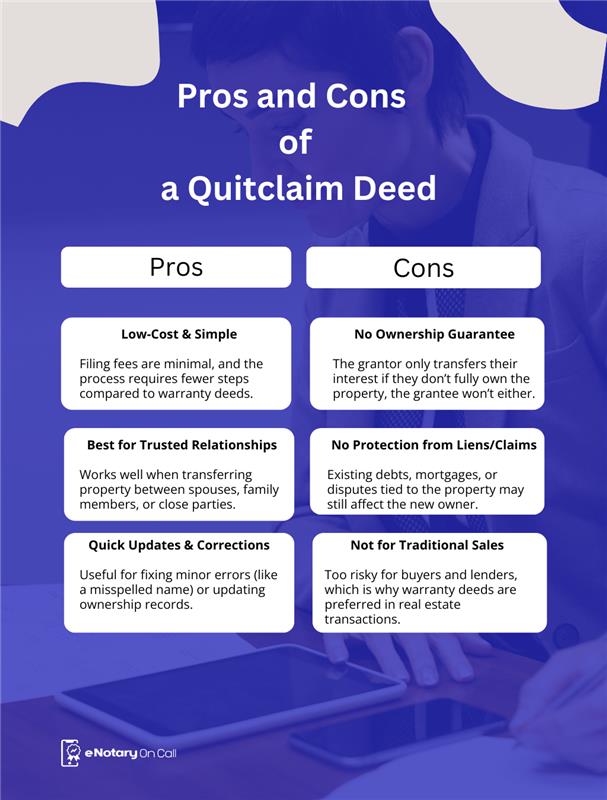When it comes to transferring property ownership, the paperwork can feel overwhelming. Deeds, titles, and signatures—these terms sound complicated to anyone who hears them for the first time. However, in some cases, a simpler option exists, known as a quitclaim deed for property.
A quitclaim deed of property doesn’t guarantee clear ownership, unlike other deeds. Instead, it conveys whatever interest or rights the present holder (the grantor) possesses to someone else (the grantee). Due to its simplicity, it’s usually utilized in circumstances where trust already exists between both parties, such as family members or spouses.
This article breaks down what a quitclaim deed is, when it’s commonly used, and how to complete a property deed transfer step by step. Take a 2-minute read.
What Exactly is a Quitclaim Deed?
Consider a quitclaim deed for property as a straightforward way to transfer ownership rights. The grantor says, “Whatever claim I have to this property, I’m giving it to you.” No guarantees, no promises—just a transfer of interest. Isn’t it simple and quick?
That’s why it’s not typically used in traditional real estate sales. Instead, a deed transfer of property through a quitclaim is more about convenience and trust.
When to Use a Quitclaim Deed?
There are several situations where a quitclaim deed for property transfer is reasonable. Below are examples explained in an easy-to-understand way for the reader to get a better understanding of it.
- Transfers Between Family Members
Parents can utilize a transfer-on-death deed to include their children in the title, or siblings can transfer ownership forward and backward for estate planning purposes. - After Marriage or Divorce
A spouse can be added to or removed from the property title with a straightforward quitclaim deed. It’s one of the most popular uses. - Placing Property within a Trust
Homeowners typically use a property quitclaim deed to transfer real property into a living trust for more convenient estate management. - Correcting Deed Mistakes
If a title contains a misspelling or mistake, a quitclaim deed can correct it promptly without much inconvenience.
It’s worth noting: although this form of property deed transfer is quick and inexpensive, it doesn’t secure the new owner against liens or claims. For that purpose, warranty deeds are typically preferred in real estate sales.
How to Complete a Quitclaim Deed Transfer?
If you’re considering a quitclaim deed for property transfer, it is essential to know how it works. To help you with the process, here’s how it typically works:
- Fill Out the Deed Form. Include the property’s legal description, the names of both parties, and the transfer details.
- Sign in Front of a Notary. The grantor must sign the document in front of a notary to make it valid.
- File with the County Recorder. File the deed with the county recording office where the property is situated. This action ensures that the transfer of the deed for the property is officially recorded.
- Pay Fees or Taxes. There might be recording fees or transfer taxes depending on your county or state.
Pros and Cons of a Quitclaim Deed!
Like any legal tool, a property quitclaim deed comes with both benefits and drawbacks. How you can make the most of it—and what you can avoid—depends on having the correct information.
Pros
1. Low-cost, easy process
2. Ideal for trusted relationships (spouses, family, etc.)
3. Efficient method to update or correct ownership records
Cons
1. No assurance that ownership is clear
2. Doesn’t secure against liens or claims
3. Not suited for traditional real estate transactions

Key Point to Remember!
No doubt a quitclaim is a legally accepted deed, but at the same time, it is always better to make the official document secure. For this, connecting with a notary public to get notarization is the right decision. To simplify the process, there are now many online notarization platforms available where notary publics provide notary services. Thus, choosing a trusted and certified RON platform will make the notarization a task of just a few minutes.
A quick guide to online notarization:
- Select a reputable platform and sign up using your confidential credentials.
- Upload documents to be notarized.
- Connect with notary officials, verify your identity, and confirm the document you are notarizing.
- Get the signature on the document, complete the payment, and download the document to produce wherever required.
Final Thought
A quitclaim deed to property is a fast and easy method for transferring the interests of different parties in real estate, such as when spouses marry or divorce, or when relatives pass on their assets or move them into trusts. However, since it does not guarantee clear ownership, it should be exercised carefully and only in suitable circumstances.
If you’re considering transferring ownership of a property, even if it is with someone not close to your inner circle, consulting a real estate attorney or title company is always a good idea. They can also provide assurance that the transfer won’t leave you exposed to potential legal issues and that your assets will be protected.
Once you understand what a quitclaim deed for property transfer is, you’ll have a better idea of how to go about a deed transfer of property and save yourself unnecessary heartburn in the long run.

If you’re looking for an easy way to notarize documents, connect with the eNotary On Call team. The customer support will guide you through the steps to perform while utilizing the platform.



